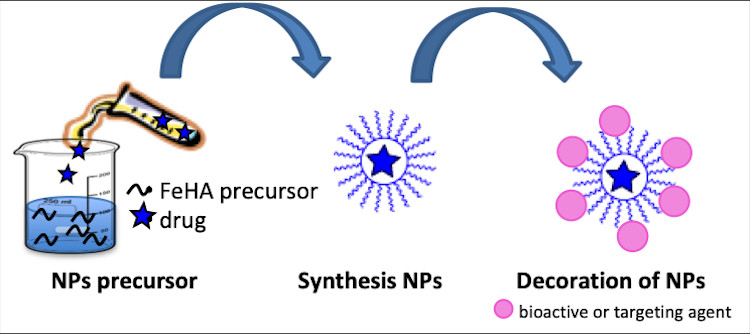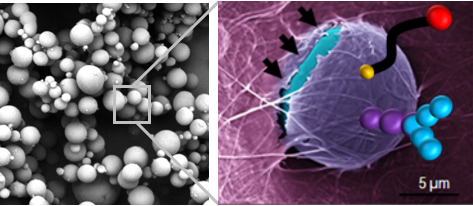Biodegradable hydroxyapatite for targeted and controlled drug delivery
Principal investigators: Michele Iafisco, Alessio Adamiano, Monica Sandri, Anna Tampieri
Personnel involved: Simone Sprio, Elisabetta Campodoni, Massimiliano Dapporto, Silvia Panseri, Monica Montesi, Lorenzo Degli Esposti, Francesca Carella
The activity addresses the development of nanosize calcium phosphate doped with biologically-relevant ions, in the form of pure ceramic or hybrids obtained through biologically inspired mineralization processes. This approach permits to obtain bio-devices with biomimetic nanostructure and composition, enabling multifunctional ability and featuring high biocompatibility and stability to protect and transport drugs and other bioactive molecules to the desired target.
Amorphous calcium phosphates (CaP) mimicking the main inorganic component that constitutes bones and teeth ensure improved biocompatibility and safety, due to the absence of inorganic or metallic residues typical of inorganic nanoparticles. They have a pH-dependent stability; particularly in physiological acid environments, CaP completely dissolve in ionic constituents (calcium and phosphate) and progressively release the drug.
Hydroxyapatite (HA, Ca5 (PO4) 3 (OH)) is the main mineral component of bones. Its crystal structure, containing only calcium and phosphate ions in the basic form, is extremely flexible and allow to introduce and / or replace a variety of foreign ions such as carbonate, magnesium, strontium and fluorides, including magnetic ions such as iron II and III and fluorescent ions such as Eu.
A superparamagnetic (FeHA) material was developed, obtained by inserting Fe (II) and Fe (III) ions within the HA structure. This material produced in nano-particle form was subsequently tested as a multi-functional nano system for various applications in the biomedical and nanomedicine field as shown below:
- FeHA for specific transport of biomolecules. FeHA nanoparticles have a high load capacity compared to some iron oxide particles commonly used in nanomedicine. Their surface also allows their functionalization with a high number of molecules (e.g. DNA / RNA, miRNA, aptamers). This material is currently the subject of an EU research project called CUPIDO, for the treatment of cardiovascular diseases by inhalation.
- CaP for bone regeneration and transport and release of anticancer medicines in nanomedicine. Calcium phosphates are biocompatible, bioactive, non-toxic and resorbable by the body. In fact, these materials do not accumulate in the kidneys or in the liver like other particles used in nanomedicine; moreover being constituted by the same elements forming hard tissues, they promote the regrowth and regeneration of bones and teeth. For these reasons and for their ability to bind with anticancer medicines, CaPs are perfect nanocarriers for the treatment of tumors, particularly metastases in bone tumors. Currently the CaP nanoparticles are objects of study within an EU project called CUPIDO, for the therapy of cardiovascular diseases by inhalation.
Nano (MHNs) and micro (MHMs) magnetic hybrids as transport and release systems in nanomedicine.
FeHA nanoparticles are nucleated on an alginate matrix (MHNs) or recombinant peptide-derived collagen by a bio-inspired mineralization process. During this process the organic phase imposes a spatial and chemical constraint on the nucleation of the apatitic phase which leads to the formation of biomimetic nanostructured crystals and with a low order of crystallinity typical of the mineral phase of natural fabrics. These highly biomimetic devices therefore enable a bioactive molecule to be encapsulated, transported in a controlled manner to the desired target and degraded by releasing completely non-toxic by-products. Thanks to various synthesis processes it is possible to obtain nano or micro-beads depending on the application.
Equipment and processes
- Drug loading evaluation
- Drug release evaluation
- Carrier+drug system characterization



Projects
- CUPIDO
- BIOINSPIRE
- NANOMAX
- MAGISTER
Publications & Patents
- Miragoli, M., Ceriotti, P., Iafisco, M., Vacchiano, M., Salvarani, N., Alogna, A., … & Rossi, F. (2018). Inhalation of peptide-loaded nanoparticles improves heart failure. Science translational medicine, 10(424), eaan6205.
- Di Mauro, V., Iafisco, M., Salvarani, N., Vacchiano, M., Carullo, P., Ramírez-Rodríguez, G.B., Patrício, T., Tampieri, A., Miragoli, M. and Catalucci, D., 2016. Bioinspired negatively charged calcium phosphate nanocarriers for cardiac delivery of MicroRNAs. Nanomedicine, 11(8), pp.891-906.
- Iafisco, M., Drouet, C., Adamiano, A., Pascaud, P., Montesi, M., Panseri, S., Sarda, S. and Tampieri, A., 2016. Superparamagnetic iron-doped nanocrystalline apatite as a delivery system for doxorubicin. Journal of Materials Chemistry B, 4(1), pp.57-70.
- Rodríguez-Ruiz, I., Delgado-López, J.M., Durán-Olivencia, M.A., Iafisco, M., Tampieri, A., Colangelo, D., Prat, M. and Gómez-Morales, J., 2013. pH-responsive delivery of doxorubicin from citrate–apatite nanocrystals with tailored carbonate content. Langmuir, 29(26), pp.8213-8221.
- Campodoni, E., Adamiano, A., Dozio, S.M., Panseri, S., Montesi, M., Sprio, S., Tampieri, A. and Sandri, M., 2016. Development of innovative hybrid and intrinsically magnetic nanobeads as a drug delivery system. Nanomedicine, 11(16), pp.2119-2130.
- Patrício, T.M.F., Panseri, S., Sandri, M., Tampieri, A. and Sprio, S., 2017. New bioactive bone-like microspheres with intrinsic magnetic properties obtained by bio-inspired mineralisation process. Materials Science and Engineering: C, 77, pp.613-623.
- Minardi, S., Corradetti, B., Taraballi, F., Sandri, M., Martinez, J.O., Powell, S.T., Tampieri, A., Weiner, B.K. and Tasciotti, E., 2016. Biomimetic concealing of PLGA microspheres in a 3D scaffold to prevent macrophage uptake. Small, 12(11), pp.1479-1488.
- Minardi, S., Sandri, M., Martinez, J.O., Yazdi, I.K., Liu, X., Ferrari, M., Weiner, B.K., Tampieri, A. and Tasciotti, E., 2014. Multiscale patterning of a biomimetic scaffold integrated with composite microspheres. Small, 10(19), pp.3943-3953.
- Brevetto Internazionale (PCT/IB2011/053362) WO2012014172: Intrinsically Magnetic Hydroxyapatite. Tampieri A., Landi E., Sandri M., Pressato D., Rivas Rey J., Banobre Lopez M., Marcacci M.
- Brevetto Internazionale (PCT/IB2006/002844) WO2007045954: A plurisubstituted hydroxyapatite and the composite thereof with a natural and/or synthetic polymer, their preparation and uses thereof. Landi E., Tampieri A., Celotti G., Sprio S., Pressato D., De Luca C.